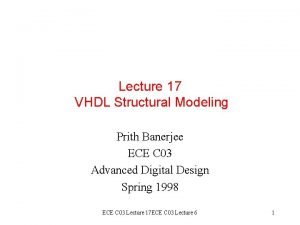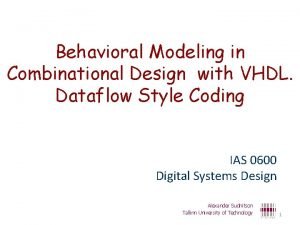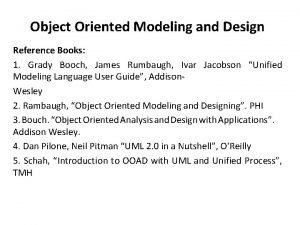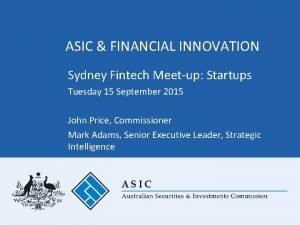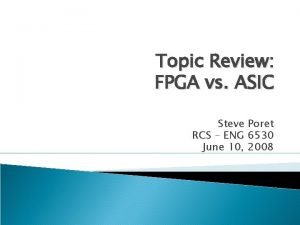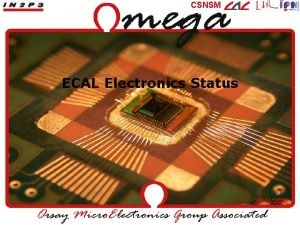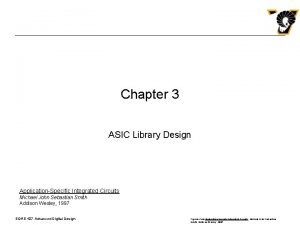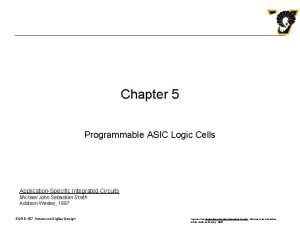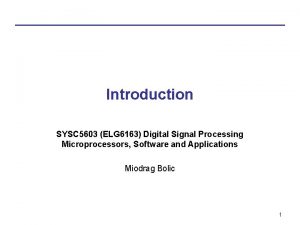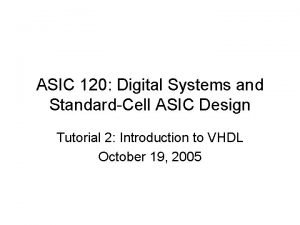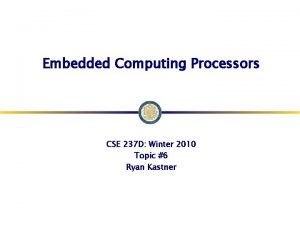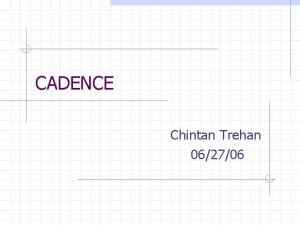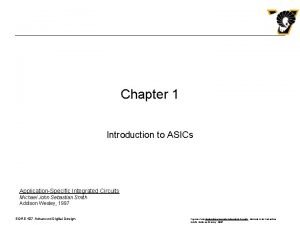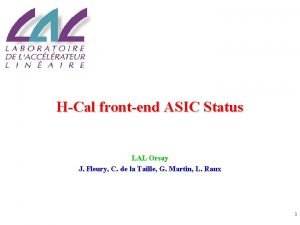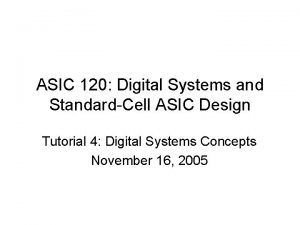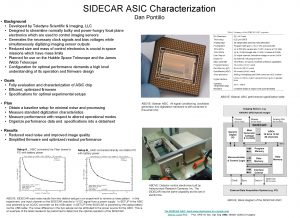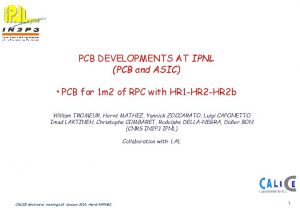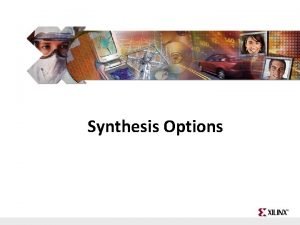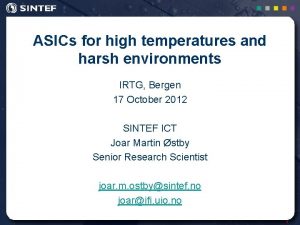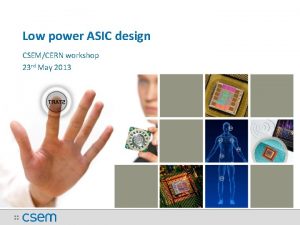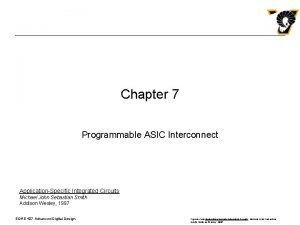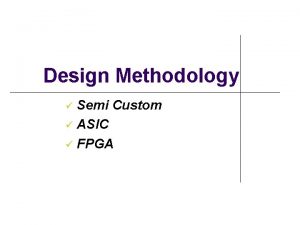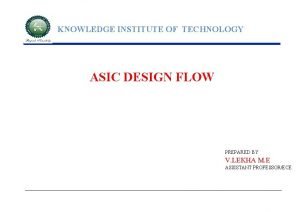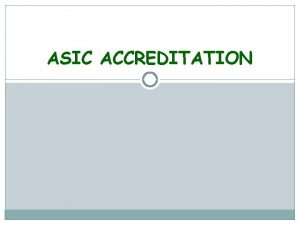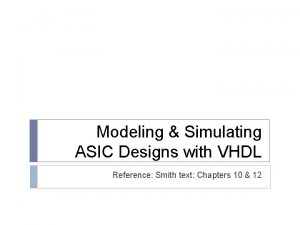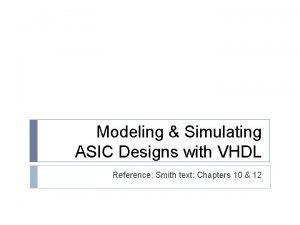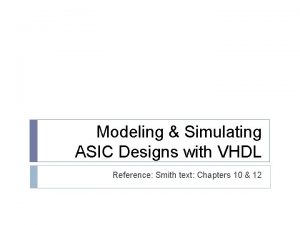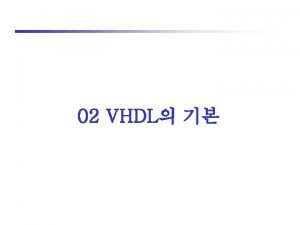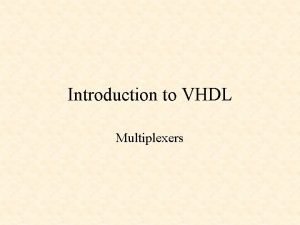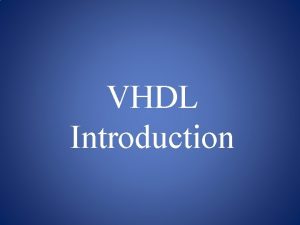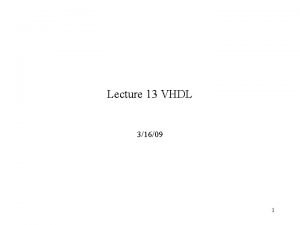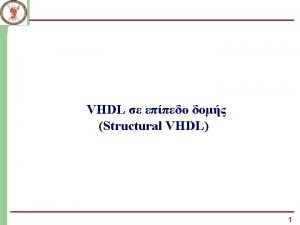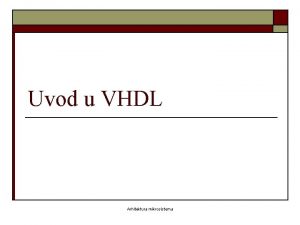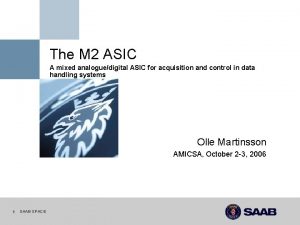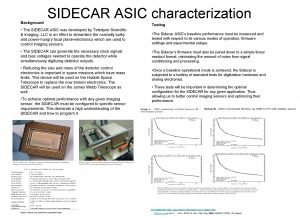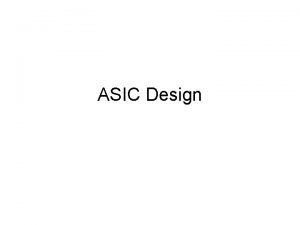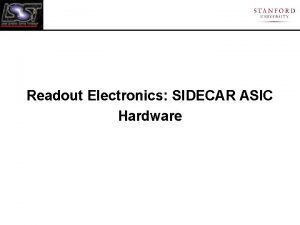Modeling Simulating ASIC Designs with VHDL Reference Smith





















![VHDL “Process” Construct [label: ] process (sensitivity list) declarations begin sequential statements end process; VHDL “Process” Construct [label: ] process (sensitivity list) declarations begin sequential statements end process;](https://slidetodoc.com/presentation_image/2288cc14e113599e2082c5a2b5a8f88a/image-22.jpg)



















- Slides: 41

Modeling & Simulating ASIC Designs with VHDL Reference: Smith text: Chapters 10 & 12


HDLs in Digital System Design Model and document digital systems Hierarchical models System, RTL (Register Transfer Level), Gates Different levels of abstraction Behavior, structure Verify circuit/system design via simulation Automated synthesis of circuits from HDL models using a technology library output is primitive cell-level netlist (gates, flip flops, etc. )

Anatomy of a VHDL model “Entity” describes the external view of a component “Architecture” describes the internal behavior and/or structure of the component Example: 1 -bit full adder Full Adder A Sum B Cin Cout

Example: 1 -Bit Full Adder entity full_add 1 is port ( a: in bit; b: in bit; cin: in bit; sum: out bit; cout: out bit); end full_add 1 ; -- I/O ports -- addend input -- augend input -- carry input -- sum output -- carry output I/O Port Declarations Comments follow double-dash Type of signal Signal name Signal direction (mode)

Port: Identifier: Mode Data_type; Identifier (naming) rules: Can consist of alphabet characters (a-z), numbers (0 -9), and underscore (_) First character must be a letter (a-z) Last character cannot be an underscore Consecutive underscores are not allowed Upper and lower case are equivalent (case insensitive) VHDL keywords cannot be used as identifiers 1 of 3

Port: Identifier: Mode Data_type; Mode in - driven into the entity from an external source (can read, but not update within architecture) out - driven from within the entity (can drive but not read within architecture) inout – bidirectional; drivers both within the entity and external (can read or write within architecture) buffer – like “out” but can read and write 2 of 3

Port: Identifier: Mode Data_type; Data_type: = scalar or aggregate signal type Scalar (single-value) signal types: bit – values are ‘ 0’ or ‘ 1’ std_logic – same as bit, but for standard simulation/synthesis (IEEE standard 1164) integer - values [-231 … +(231 -1)] on 32 -bit host Aggregate (multi-value) signal types: bit_vector – array of bits std_logic_vector – array of std_logic (IEEE 1164) All vectors must have a range specified: Ex. bit_vector(3 downto 0) or std_logic_vector(0 to 3) 3 of 3

IEEE std_logic_1164 package -- For simulation and synthesis, std_logic preferred over bit. -- Provides additional logic states as data values type STD_LOGIC is ( 'U', -- Uninitialized 'X', -- Forcing Unknown '0', -- Forcing 0 '1', -- Forcing 1 'Z', -- High Impedance 'W', -- Weak Unknown 'L', -- Weak 0 'H', -- Weak 1 '-' -- Don't Care); You must include the library and package declarations in the VHDL model before the entity. (Example on next slide)

Example: 8 -bit full adder -- Adder with 8 -bit inputs/outputs library ieee; --supplied library use ieee. std_logic_1164. all; --package of definitions entity full_add 8 is port ( a: in std_logic_vector(7 downto 0); b: in std_logic_vector(7 downto 0); cin: in std_logic; sum: out std_logic _vector(7 downto 0); cout: out std_logic); end full_add 8 ;

Format for Architecture body architecture_name of entity_name is -- data type definitions (ie, states, arrays, etc. ) -- internal signal declarations signal_name: signal_type; : signal_name: signal_type; -- component declarations – see format below -- function and procedure declarations begin -- behavior of the model is described here and consists of concurrent interconnecting: -- component instantiations -- processes -- concurrent statements including: Signal Assignment statements When-Else statements With-Select-When statements end architecture_name; Note: entity and architecture in the end statement is optional.

Architecture defines function/structure -- behavioral model (no circuit structure implied) architecture dataflow of full_add 1 is signal x 1: std_logic; -- internal signal begin x 1 <= a xor b after 1 ns; sum <= x 1 xor cin after 1 ns; cout <= (a and b) or (a and cin) or (b and cin) after 1 ns; end;

Structural architecture example (no “behavior” specified) architecture structure of full_add 1 is component xor -- declare component to be used port (x, y: in bit; z: out bit); end component; for all: xor use entity work. xor(eqns); -- if multiple arch’s signal x 1: bit; -- signal internal to this component begin G 1: xor port map (a, b, x 1); -- instantiate 1 st xor gate G 2: xor port map (x 1, cin, sum); -- instantiate 2 nd xor gate …add circuit for carry output… end;

Associating signals with formal ports component And. Gate port (Ain_1, Ain_2 : in BIT; Aout : out BIT); end component; -- formal parameters -- positional association: A 1: And. Gate port map (X, Y, Z 1); -- named association: A 2: And. Gate port map (Ain_2=>Y, Aout=>Z 2, Ain_1=>X); -- both (positional must begin from leftmost formal): A 3: And. Gate port map (X, Aout => Z 3, Ain_2 => Y);

Example: D flip-flop entity DFF is port (Preset: in bit; Clear: in bit; Clock: in bit; Data: in bit; Q: out bit; Qbar: out bit); end DFF; Preset Data Q Clock Qbar Clear

7474 D flip-flop equations architecture eqns of DFF is signal A, B, C, D: bit; signal QInt, QBar. Int: bit; begin A <= not (Preset and D and B) after 1 ns; B <= not (A and Clear and Clock) after 1 ns; C <= not (B and Clock and D) after 1 ns; D <= not (C and Clear and Data) after 1 ns; Qint <= not (Preset and B and Qbar. Int) after 1 ns; QBar. Int <= not (QInt and Clear and C) after 1 ns; Q <= QInt; -- Can drive but not read “outs” QBar <= QBar. Int; -- Can read & drive “internals” end;

4 -bit Register (Structural Model) entity Register 4 is port ( D: in bit_vector(0 to 3); Q: out bit_vector(0 to 3); Clk: in bit; Clr: in bit; Pre: in bit); end Register 4; D(3) D(2) D(1) D(0) CLK PRE CLR Q(3) Q(2) Q(1) Q(0)

Register Structure architecture structure of Register 4 is component DFF -- declare library component to be used port (Preset: in bit; Clear: in bit; Clock: in bit; Data: in bit; Q: out bit; Qbar: out bit); end component; signal Qbar: bit_vector(0 to 3); -- dummy for unused FF outputs begin -- Signals connect to ports in order listed above F 3: DFF port map (Pre, Clr, Clk, D(3), Qbar(3)); F 2: DFF port map (Pre, Clr, Clk, D(2), Qbar(2)); F 1: DFF port map (Pre, Clr, Clk, D(1), Qbar(1)); F 0: DFF port map (Pre, Clr, Clk, D(0), Qbar(0)); end;

Conditional Signal Assignment signal a, b, c, d, y: std_logic; signal S: std_logic_vector(0 to 1); 4 -to-1 Mux begin 00 a with S select 01 b y <= a after 1 ns when “ 00”, 10 c b after 1 ns when “ 01”, c after 1 ns when “ 10”, 11 d d after 1 ns when “ 11”; S --Alternative “default”: d after 1 ns when others; y

32 -bit-wide 4 -to-1 multiplexer signal a, b, c, d, y: bit_vector(0 to 31); signal S: bit_vector(0 to 1); a begin b with S select y <= a after 1 ns when “ 00”, c b after 1 ns when “ 01”, d c after 1 ns when “ 10”, d after 1 ns when “ 11”; 4 -to-1 Mux 00 01 y 10 11 S --a, b, c, d, y can be any type, as long as they are the same

Conditional Signal Assignment – Alternate Format y <= a after 1 ns when (S=“ 00”) else b after 1 ns when (S=“ 01”) else c after 1 ns when (S=“ 10”) else d after 1 ns; 4 -to-1 Mux a 00 b 01 c 10 d 11 Use any boolean expression for each condition: y <= a after 1 ns when (F=‘ 1’) and (G=‘ 0’) … y S
![VHDL Process Construct label process sensitivity list declarations begin sequential statements end process VHDL “Process” Construct [label: ] process (sensitivity list) declarations begin sequential statements end process;](https://slidetodoc.com/presentation_image/2288cc14e113599e2082c5a2b5a8f88a/image-22.jpg)
VHDL “Process” Construct [label: ] process (sensitivity list) declarations begin sequential statements end process; Process statements executed once at start of simulation Process halts at “end” until an event occurs on a signal in the “sensitivity list” Allows conventional programming language methods to describe circuit behavior

Modeling sequential behavior -- Edge-triggered flip flop/register entity DFF is port (D, CLK: in bit; Q: out bit); end DFF; architecture behave of DFF is begin process(clk) -- “process sensitivity list” begin if (clk’event and clk=‘ 1’) then Q <= D after 1 ns; end if; end process; end; � � D Q CLK Process statements executed sequentially (sequential statements) clk’event is an attribute of signal clk which is TRUE if an event has occurred on clk at the current simulation time

Edge-triggered flip-flop Alternative methods for specifying clock process (clk) begin if rising_edge(clk) then -- std_logic_1164 function Q <= D ; end if; end process; Leonardo also recognizes not clk’stable as equivalent to clk’event

Alternative to sensitivity list process -- no “sensitivity list” begin wait on clk; -- suspend process until event on clk if (clk=‘ 1’) then Q <= D after 1 ns; end if; end process; � Other “wait” formats: D CLK wait until (clk’event and clk=‘ 1’) wait for 20 ns; � This format does not allow for asynchronous controls � Process executes endlessly if no sensitivity list or wait statement! Q

Level-Sensitive D latch vs. D flip-flop entity Dlatch is port (D, CLK: in bit; Q: out bit); end Dlatch; architecture behave of Dlatch is begin process(D, clk) begin if (clk=‘ 1’) then Q <= D after 1 ns; end if; end process; end; D Q CLK Latch, Q changes whenever the latch is enabled by CLK=‘ 1’ (rather than edge-triggered)

Defining a “register” for an RTL model (not gate-level) entity Reg 8 is port (D: in bit_vector(0 to 7); Q: out bit_vector(0 to 7); D(0 to 7) LD: in bit); end Reg 8; architecture behave of Reg 8 is. LD Reg 8 begin process(LD) begin Q(0 to 7) if (LD’event and LD=‘ 1’) then Q <= D after 1 ns; end if; end process; end; D and Q could be any abstract data type

Basic format for synchronous and asynchronous inputs process (clock, asynchronously_used_signals ) begin if (boolean_expression) then asynchronous signal_assignments elsif (boolean_expression) then asynchronous signal assignments elsif (clock’event and clock = contstant) then synchronous signal_assignments end if ; end process;

Synchronous vs. Asynchronous Flip-Flop Inputs entity DFF is port (D, CLK: in bit; PRE, CLR: in bit; CLR Q: out bit); D Q end DFF; architecture behave of DFF is CLK begin PRE process(clk, PRE, CLR) begin if (CLR=‘ 0’) then -- async CLR has precedence Q <= ‘ 0’ after 1 ns; elsif (PRE=‘ 0’) then -- then async PRE has precedence Q <= ‘ 1’ after 1 ns; elsif (clk’event and clk=‘ 1’) then Q <= D after 1 ns; -- sync operation only if CLR=PRE=‘ 1’ end if; end process; end;

Modeling Finite State Machines (Synchronous Sequential Circuits) FSM design & synthesis process: 1. 2. 3. 4. 5. 6. Design state diagram (behavior) Derive state table Reduce state table Choose a state assignment Derive output equations Derive flip-flop excitation equations Synthesis steps 2 -6 can be automated, given the state diagram

Synchronous Sequential Circuit Model Inputs x Outputs z Comb. Logic Present State y Next State Y FFs Clock Mealy Outputs z = f(x, y), Moore Outputs z = f(y) Next State Y = f(x, y)

Synchronous Sequential Circuit (FSM) Example

FSM Example – entity definition entity seqckt is port ( x: in bit; -- FSM input z: out bit; -- FSM output clk: in bit ); -- clock end seqckt;

FSM Example - behavioral model architecture behave of seqckt is type states is (A, B, C); -- symbolic state names (enumerate) signal curr_state, next_state: states; begin -- Model the memory elements of the FSM process (clk) begin if (clk’event and clk=‘ 1’) then pres_state <= next_state; end if; end process; (continue on next slide)

FSM Example - continued -- Model next-state and output functions of the FSM process (x, pres_state) -- function inputs begin case pres_state is -- describe each state when A => if (x = ‘ 0’) then z <= ‘ 0’; next_state <= A; else -- if (x = ‘ 1’) z <= ‘ 0’; next_state <= B; end if; (continue next slide for pres_state = B and C)

FSM Example (continued) when B => if (x=‘ 0’) then z <= ‘ 0’; next_state <= A; else z <= ‘ 1’; next_state <= C; end if; when C => if (x=‘ 0’) then z <= ‘ 0’; next_state <= C; else z <= ‘ 1’; next_state <= A; end if; end case; end process;

Alternative Format for Output and Next State Functions -- Output function z <= ‘ 1’ when ((curr_state = B) and (x = ‘ 1’)) or ((curr_state = C) and (x = ‘ 1’)) else ‘ 0’; -- Next state function next_state <= A when ((curr_state = A) and (x = ‘ 0’)) or ((curr_state = B) and (x = ‘ 0’)) or ((curr_state = C) and (x = ‘ 1’)) else B when ((curr_state = 1) and (x = ‘ 1’)) else C;

library IEEE; use IEEE. STD_LOGIC_1164. all; entity SM 1 is port (a. In, clk : in Std_logic; y. Out: out Std_logic); end SM 1; architecture Moore of SM 1 is type state is (s 1, s 2, s 3, s 4); signal p. S, n. S : state; begin process (a. In, p. S) begin – next state and output functions case p. S is when s 1 => y. Out <= '0'; n. S <= s 4; --Moore: y. Out = f(p. S) when s 2 => y. Out <= '1'; n. S <= s 3; when s 3 => y. Out <= '1'; n. S <= s 1; when s 4 => y. Out <= '1'; n. S <= s 2; end case; end process; process begin wait until clk = '1'; p. S <= n. S; -- update state variable on next clock end process; end Moore;

library IEEE; use IEEE. STD_LOGIC_1164. all; entity SM 2 is port (a. In, clk : in Std_logic; y. Out: out Std_logic); end SM 2; architecture Mealy of SM 2 is type state is (s 1, s 2, s 3, s 4); signal p. S, n. S : state; begin process(a. In, p. S) begin -- Mealy: y. Out & n. S are functions of a. In and p. S case p. S is when s 1 => if (a. In = '1') then y. Out <= '0'; n. S <= s 4; else y. Out <= '1'; n. S <= s 3; end if; when s 2 => y. Out <= '1'; n. S <= s 3; when s 3 => y. Out <= '1'; n. S <= s 1; when s 4 => if (a. In = '1') then y. Out <= '1'; n. S <= s 2; else y. Out <= '0'; n. S <= s 1; end if; end case; end process; process begin wait until clk = '1' ; p. S <= n. S; end process; end Mealy;

when s 1 => -- initiate row access ras <= ’ 0’ ; cas <= ’ 1’ ; ready <= ’ 0’ ; next_state <= s 2 ; when s 2 => -- initiate column access ras <= ’ 0’ ; cas <= ’ 0’ ; ready <= ’ 0’ ; if (cs = ’ 0’) then next_state <= s 0 ; -- end of operation if cs = 0 else next_state <= s 2 ; -- wait in s 2 for cs = 0 end if ; when s 3 => -- start cas-before-ras refresh ras <= ’ 1’ ; cas <= ’ 0’ ; ready <= ’ 0’ ; next_state <= s 4 ; when s 4 => -- complete cas-before-ras refresh ras <= ’ 0’ ; cas <= ’ 0’ ; ready <= ’ 0’ ; next_state <= s 0 ; end case ; end process ; end rtl ;

Synthesizing arithmetic circuits (12. 6. 5, 12. 6. 9, 12. 6. 10) Leonardo recognizes overloaded operators and generated corresponding circuits: “+”, “-”, “*”, and “abs” Special operations: “+1”, “-1”, unary “-” Relational Operators: “=“, “/=“, “<“, “>“, “<=“, “>=“ Use “ranged integers” instead of unbound to minimize generated logic. signal i : integer range 0 to 15;
 Vhdl asic
Vhdl asic Conditions simulating rigor mortis
Conditions simulating rigor mortis Postmortem signs
Postmortem signs Behavioural vhdl
Behavioural vhdl Structural modeling vhdl
Structural modeling vhdl Vhdl data flow modeling
Vhdl data flow modeling Object oriented modeling and design books
Object oriented modeling and design books Relational modeling vs dimensional modeling
Relational modeling vs dimensional modeling Role modeling theory
Role modeling theory Reference node and non reference node
Reference node and non reference node Reference node and non reference node
Reference node and non reference node Asic innovation hub
Asic innovation hub Fpga vs asic
Fpga vs asic Electronics
Electronics Application specific integrated circuits smith pdf
Application specific integrated circuits smith pdf The logic cells in fpga contains
The logic cells in fpga contains Sysc 2004 course outline
Sysc 2004 course outline Asic design flow tutorial
Asic design flow tutorial Asip vs asic
Asip vs asic Fowler
Fowler Asic upv
Asic upv Fpga vs microcontroller
Fpga vs microcontroller Asic
Asic Cadence asic design flow
Cadence asic design flow Gate array based asic
Gate array based asic Cr rc shaper
Cr rc shaper Regulatoryportal asic gov au
Regulatoryportal asic gov au Standardcels
Standardcels Solid state recorder side car asic
Solid state recorder side car asic Structured asic
Structured asic Asic pcb
Asic pcb Asic
Asic High temperature asic
High temperature asic Fpga to asic conversion
Fpga to asic conversion Asic-e format
Asic-e format Asic
Asic Low power asic design
Low power asic design Programmable interconnect
Programmable interconnect Semi custom asic
Semi custom asic Asic design flow
Asic design flow Sandbox perth
Sandbox perth Asic accreditation
Asic accreditation




